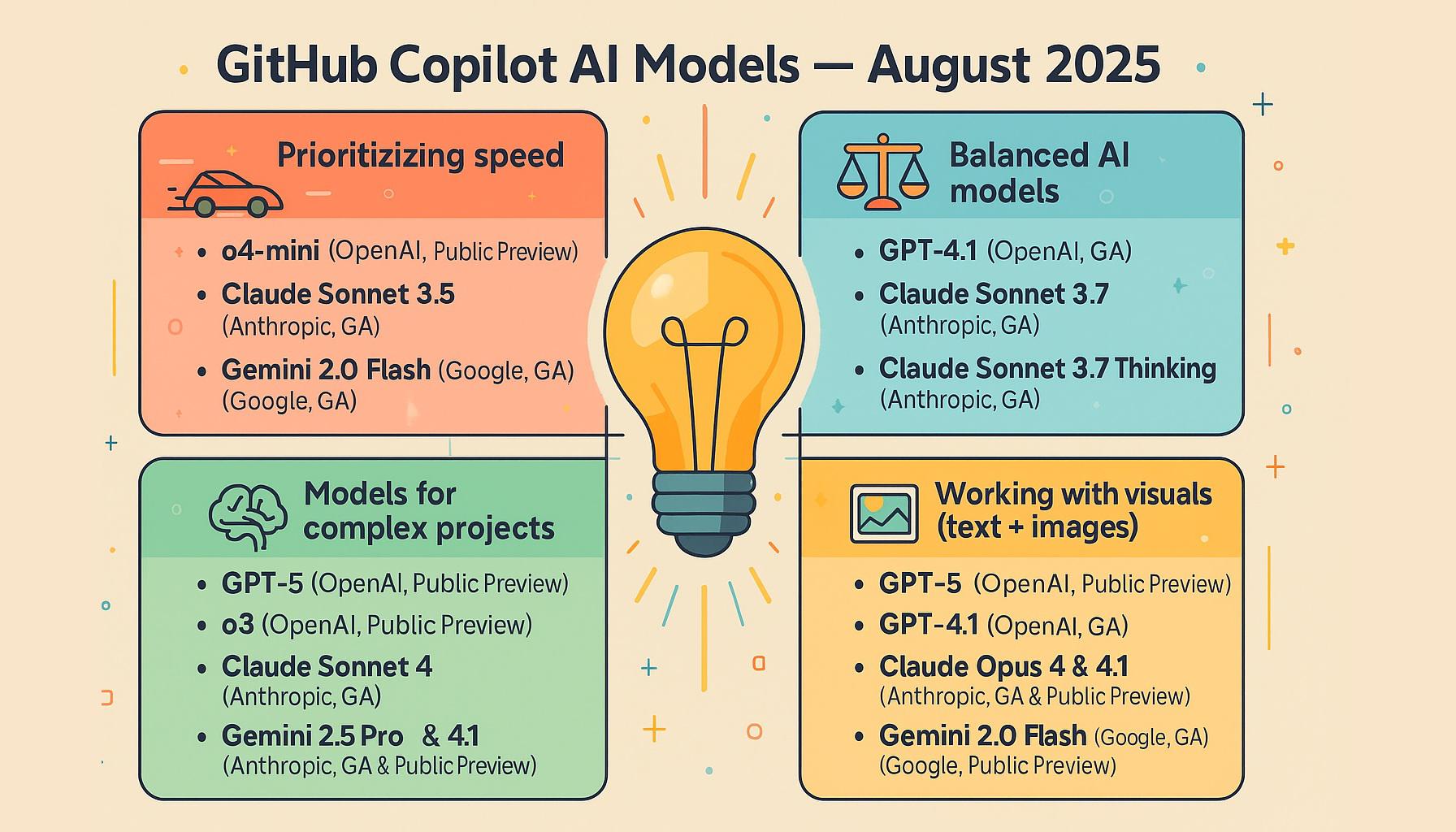Which AI Model Should You Use with GitHub Copilot?

📢 Important Update — August 2025
GitHub Copilot and ChatGPT have officially deprecated GPT-4o.
The new recommended model is GPT-5, now available in public preview for GitHub Copilot (paid plans) and default in ChatGPT.
- GitHub changelog — GPT-5 public preview
- GitHub changelog — GPT-4o deprecation
- OpenAI GPT-5 announcement
Which AI model should I use with GitHub Copilot?
Choosing the right AI model for your GitHub Copilot project can be tricky.
Each model has strengths, and matching them to your workflow will help you get better results.
Heads up!
These recommendations follow the official GitHub supported models list as of August 8, 2025.
TL;DR — Quick Recommendations
| Need | Recommended Models |
|---|---|
| Default choice | GPT-5 (new standard in Copilot & ChatGPT) |
| Balanced cost & performance | GPT-4.1, Claude Sonnet 3.7 |
| Fast/lightweight | o4-mini, Gemini 2.0 Flash |
| Deep reasoning/debugging | GPT-5, Claude Sonnet 4, Claude Opus 4 |
| Multimodal (images + text) | GPT-5, GPT-4.1, Gemini 2.0 Flash |
🏎️ Prioritizing speed
o4-mini — The speed specialist ⚡
✅ Best for:
- Rapid prototyping
- Small code snippet explanations
- Utility functions and boilerplate generation
👀 Consider other models if: You need multi-file reasoning — GPT-5 or Claude Sonnet 4 will serve you better.
Gemini 2.0 Flash — The visual sprinter 🎯
✅ Best for:
- Analyzing diagrams or UI layouts quickly
- Real-time design feedback
- Short, multimodal tasks
👀 Consider other models if: You need longer context or deeper reasoning — Gemini 2.5 Pro or GPT-5 are better choices.
⚖️ Balanced AI models
GPT-4.1 — The reliable all-rounder 🌍
✅ Best for:
- General-purpose coding and writing
- Multilingual and multimodal workflows
- Accurate, predictable completions
👀 Consider other models if: You want the latest reasoning improvements — GPT-5 offers more depth.
Claude Sonnet 3.7 — The structured coder ✍️
✅ Best for:
- Well-formatted, consistent output
- Documentation and code comments
- Large but not overly complex projects
👀 Consider other models if: You need high-pressure reasoning — Claude Sonnet 4 or GPT-5 are stronger.
🧠 Models for complex projects
GPT-5 — The next-gen problem solver 🏆
✅ Best for:
- Multi-file reasoning and debugging
- Large refactors and architecture planning
- Reducing hallucinations in complex tasks
👀 Consider other models if: Budget is tight — Claude Sonnet 4 or o3 may be cheaper alternatives.
Claude Sonnet 4 — The balanced strategist 🏠
✅ Best for:
- Complex workflows with high reliability
- Balancing speed and reasoning depth
- Coding under pressure
👀 Consider other models if: You need extreme
🖼️ Working with visuals (text + images)
Some Copilot models can work with both code and visuals — for example, diagrams, screenshots, or UI mockups.
This can be useful for debugging layouts, interpreting architecture diagrams, or generating code based on design references.
GPT-5 — The unified visual + reasoning model 🎨
✅ Best for:
- Combining diagram analysis with code context
- Visual-assisted debugging and planning
👀 Consider other models if: You only need pure text/code completion — GPT-4.1 or o4-mini may be faster.
GPT-4.1 — The dependable visualist 👁️
✅ Best for:
- Code + diagram combined workflows
- Multilingual documentation with visual references
👀 Consider other models if: You need deeper reasoning — GPT-5 offers more advanced problem solving.
Claude Opus 4 — The visual architect 🏛️
✅ Best for:
- Debugging complex UI layouts
- Reviewing and refining design prototypes
👀 Consider other models if: Cost is a concern — Claude Sonnet 4 can be more budget-friendly.
Claude Sonnet 4 — The balanced visual coder 📐
✅ Best for:
- Day-to-day coding with occasional visual analysis
- Merging visual and textual reasoning without big performance hits
👀 Consider other models if: Your visuals require deep, long-context reasoning — Claude Opus 4 or GPT-5 may be better.
Gemini 2.0 Flash — The instant visual helper ⚡
✅ Best for:
- Real-time UI feedback
- Diagram-based code generation
- Rapid layout debugging
👀 Consider other models if: You need detailed, research-level analysis — Gemini 2.5 Pro or GPT-5 are stronger.
Gemini 2.5 Pro — The deep visual analyst 🔬
✅ Best for:
- Detailed multimodal reasoning
- Complex, long-context visual projects
👀 Consider other models if: You want instant responses — Gemini 2.0 Flash is faster.